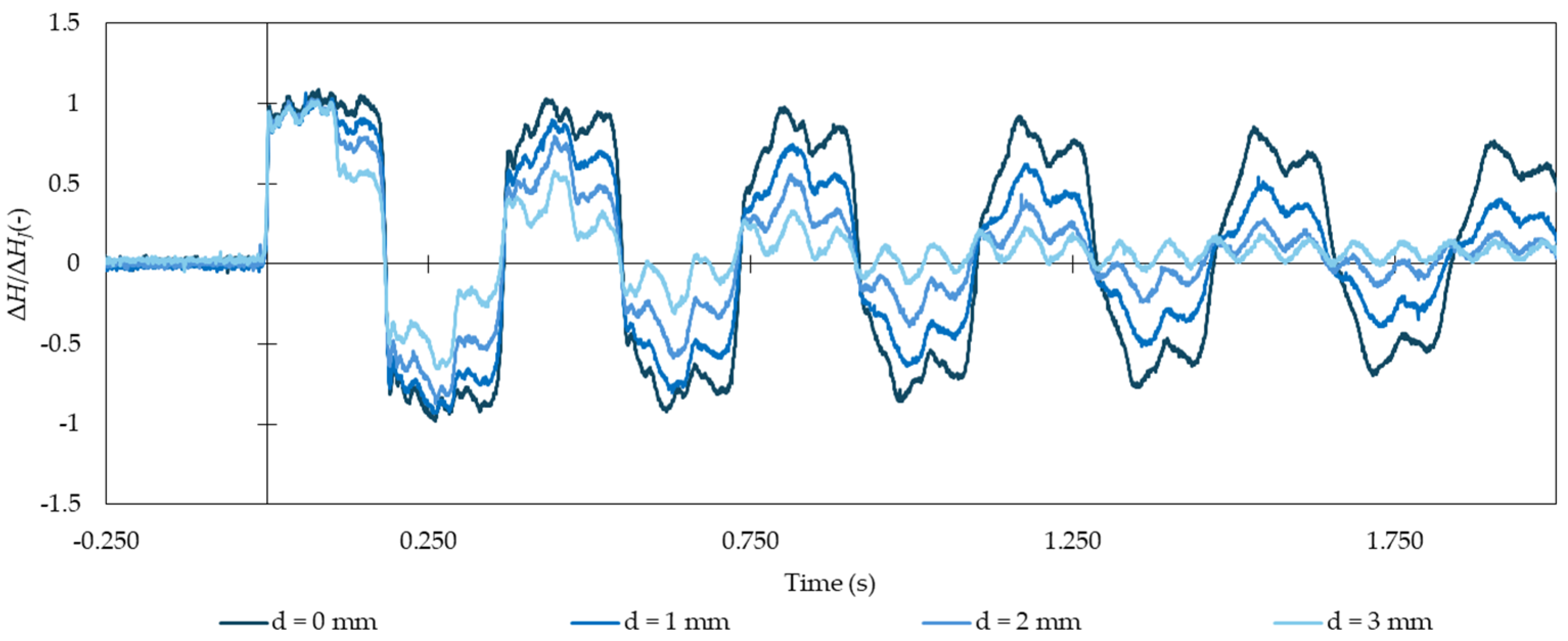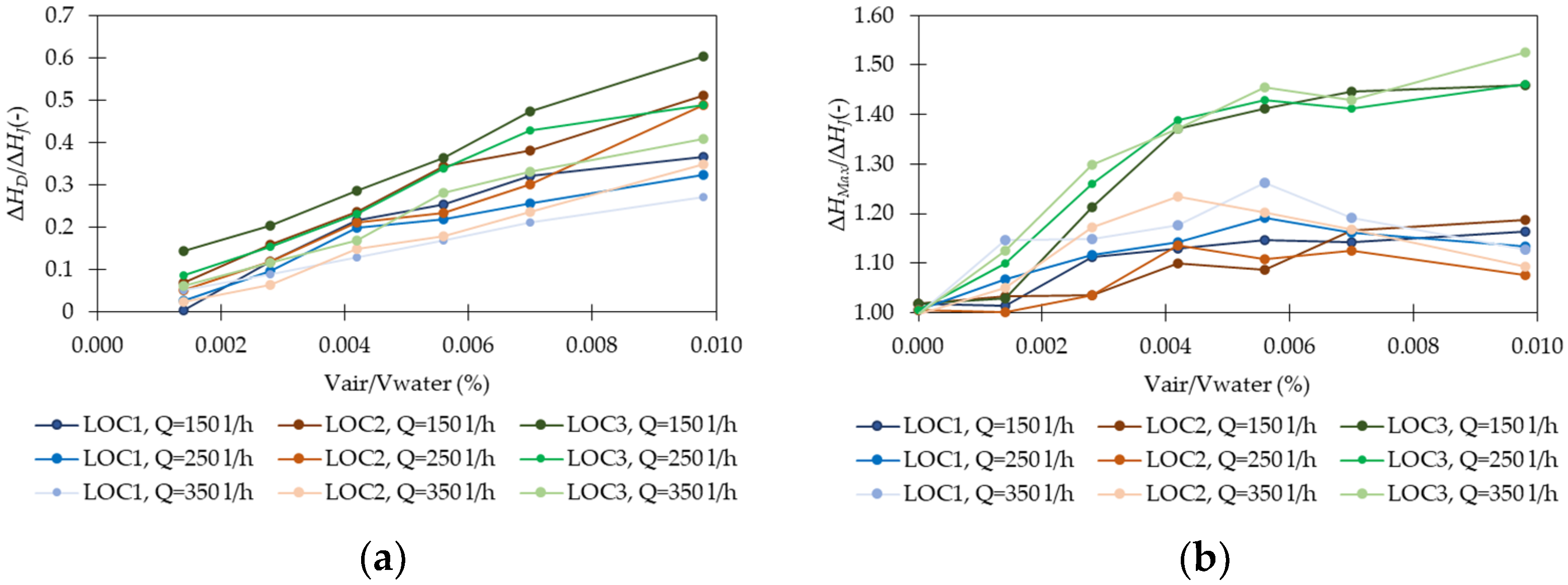Contributions to Leak and Air Pocket Detection Using Transient Pressure Signals †
Abstract
:1. Introduction
2. Experimental Facilities
3. Effect of Leaks in the Pressure Signal
4. Effect of Air Pockets in the Pressure Signal
5. Conclusions
Author Contributions
Funding
Institutional Review Board Statement
Informed Consent Statement
Data Availability Statement
Conflicts of Interest
References
- Naderi, M.J.; Pishvaee, M.S. Robust bi-objective macroscopic municipal water supply network redesign and rehabilitation. Water Resour. Manag. 2017, 31, 2689–2711. [Google Scholar] [CrossRef]
- Covas, D.I.C. Inverse Transient Analysis for Leak Detection and Calibration of Water Pipe Systems Modelling Special Dynamic Effects. Ph.D. Thesis, Imperial College, London, UK, 2003. [Google Scholar]
- Bergant, A.; Tijsseling, A.; Kim, Y.-i.; Karadžić, U.; Zhou, L.; Lambert, M.F.; Simpson, A.R. Unsteady Pressures Influenced by Trapped Air Pockets in Water-Filled Pipelines. Stroj. Vestn.-J. Mech. Eng. 2018, 64, 501–512. [Google Scholar]
- Alexander, J.M.; Lee, P.J.; Davidson, M.; Li, Z.; Murch, R.; Duan, H.-F.; Meniconi, S.; Brunone, B. Experimental Investigation of the Interaction of Fluid Transients with an In-Line Air Pocket. J. Hydraul. Eng. 2020, 146, 04019067. [Google Scholar] [CrossRef]
- Loureiro, D.; Amado, C.; Martins, A.; Vitorino, D.; Mamade, A.; Coelho, S.T. Water distribution systems flow monitoring and anomalous event detection: A practical approach. Urban Water J. 2016, 13, 242–252. [Google Scholar] [CrossRef]
- Ferràs, D.; Manso, P.A.; Schleiss, A.J.; Covas, D.I.C. Experimental distinction of damping mechanisms during hydraulic transients in pipe flow. J. Fluids Struct. 2016, 66, 424–446. [Google Scholar] [CrossRef]
- Ferreira, J.P.; Ghezzi, E.; Ferrante, M.; Covas, D.I.C. Pressure wave behaviour due to entrapped air in hydraulic transient events. In Proceedings of the 13th Pressure Surges Conference, Bordeaux, France, 14–16 November 2018. [Google Scholar]
- Ferreira, J.P.; Buttarazzi, N.; Ferras, D.; Covas, D.I.C. Effect of an entrapped air pocket on hydraulic transients in pressurized pipes. J. Hydraul. Res. 2021, 59, 1018–1030. [Google Scholar] [CrossRef]


| Test Type | Air Cavity Height (mm) | Air Volume (mm3) | Vair/Vwater (%) | Set I | Set II |
|---|---|---|---|---|---|
| AP0 | 0 | 0 | 0.0000 | x | x |
| AP1 | 1 | 20 | 0.0005 | x | |
| AP3 | 3 | 59 | 0.0014 | x | x |
| AP6 | 6 | 118 | 0.0028 | x | x |
| AP9 | 9 | 177 | 0.0042 | x | x |
| AP12 | 12 | 236 | 0.0056 | x | x |
| AP15 | 15 | 295 | 0.0070 | x | x |
| AP21 | 21 | 412 | 0.0098 | x | x |
Disclaimer/Publisher’s Note: The statements, opinions and data contained in all publications are solely those of the individual author(s) and contributor(s) and not of MDPI and/or the editor(s). MDPI and/or the editor(s) disclaim responsibility for any injury to people or property resulting from any ideas, methods, instructions or products referred to in the content. |
© 2024 by the authors. Licensee MDPI, Basel, Switzerland. This article is an open access article distributed under the terms and conditions of the Creative Commons Attribution (CC BY) license (https://creativecommons.org/licenses/by/4.0/).
Share and Cite
Covas, D.; Cabral, M.; Ferreira, J.P.; Ramos, H. Contributions to Leak and Air Pocket Detection Using Transient Pressure Signals. Eng. Proc. 2024, 69, 139. https://doi.org/10.3390/engproc2024069139
Covas D, Cabral M, Ferreira JP, Ramos H. Contributions to Leak and Air Pocket Detection Using Transient Pressure Signals. Engineering Proceedings. 2024; 69(1):139. https://doi.org/10.3390/engproc2024069139
Chicago/Turabian StyleCovas, Dídia, Marta Cabral, João Paulo Ferreira, and Helena Ramos. 2024. "Contributions to Leak and Air Pocket Detection Using Transient Pressure Signals" Engineering Proceedings 69, no. 1: 139. https://doi.org/10.3390/engproc2024069139







